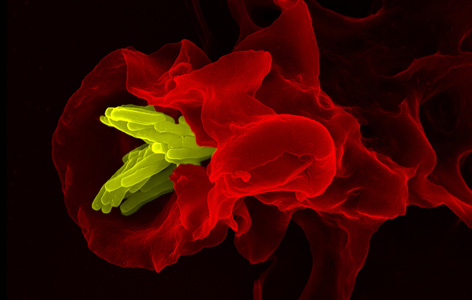
Our bodies are populated with specialized immune cells called macrophages, which maintain the health of our tissues and arteries. Although much is known about the role that they play as part of the immune system, it is not clear in certain cases where macrophages originate.
A recent study by TGHRI Senior Scientist Dr. Clinton Robbins and his collaborators has provided new insight on this subject by uncovering key mechanisms that sustain the macrophages that reside in our arteries (known as arterial macrophages).
The team made the discovery by analyzing the genetic profiles of macrophages at different stages of human development. They found that arterial macrophages, which represent a distinct macrophage population, have varying origins as we grow older.
In the embryo, arterial macrophages develop from a macrophage precursor cell that expresses a specific protein on its cell surface, known as CX3CR1. Immediately after birth, arterial macrophages originate from a different type of cell, known as a monocyte.
However, in adulthood, arterial macrophages gain the ability to divide and regenerate into cells with similar properties. This enables them to increase in number in the absence of precursor cells or monocytes.
Explains Dr. Robbins, “Our findings underscore the need for more careful examination of the factors that maintain macrophage populations in tissues. Insights from these studies could provide new strategies for treating diseases such as atherosclerosis, where abnormal accumulation of macrophages in the artery walls leads to the formation of lesions that interfere with blood flow.”
This work was supported by the Canadian Institutes of Health Research, the Ontario Lung Association Pfizer Award, the Peter Munk Chair in Aortic Disease Research and the Toronto General & Western Hospital Foundation.
Self-renewing resident arterial macrophages arise from embryonic CX3CR1(+) precursors and circulating monocytes immediately after birth. Ensan S, Li A, Besla R, Degousee N, Cosme J, Roufaiel M, Shikatani EA, El-Maklizi M, Williams JW, Robins L, Li C, Lewis B, Yun TJ, Lee JS, Wieghofer P, Khattar R, Farrokhi K, Byrne J, Ouzounian M, Zavitz CC, Levy GA, Bauer CM, Libby P, Husain M, Swirski FK, Cheong C, Prinz M, Hilgendorf I, Randolph GJ, Epelman S, Gramolini AO, Cybulsky MI, Rubin BB, Robbins CS. Nature Immunology. 2015 Dec 7. doi: 10.1038/ni.3343. [Pubmed abstract]. Image courtesy of Dr. Volker Brinkmann, Max Planck Institute for Infection Biology and is licensed under CC BY-NC-ND 2.0.




